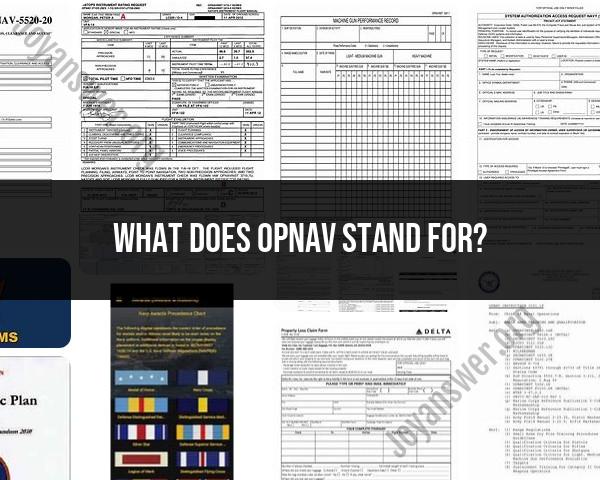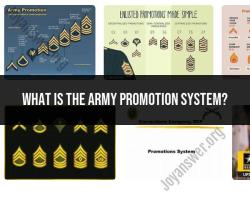What does OPNAV stand for?
OPNAV stands for "Office of the Chief of Naval Operations." The Chief of Naval Operations (CNO) is the highest-ranking officer in the United States Navy and serves as the principal military advisor to the Secretary of the Navy and the President of the United States on naval matters.
The Office of the Chief of Naval Operations (OPNAV) is the headquarters of the United States Navy and is responsible for overseeing the planning, policies, and operations of the Navy. It plays a critical role in formulating and implementing naval strategy, ensuring readiness, and coordinating activities across the various commands and fleets of the Navy.
OPNAV is divided into several directorates and offices, each focusing on specific functional areas such as operations, manpower, logistics, plans, and policy. The office works closely with other military departments, defense agencies, and government organizations to achieve the Navy's mission and objectives.
In addition to providing strategic guidance and direction, OPNAV issues directives and instructions, often referred to as OPNAVINSTs (Office of the Chief of Naval Operations Instructions), which provide detailed policies, procedures, and guidance for Navy personnel on a wide range of topics.
Overall, OPNAV plays a central role in the leadership and management of the U.S. Navy, ensuring that the Navy is prepared to fulfill its mission of maintaining maritime security, projecting power, and protecting national interests around the world.
The full meaning of OPNAV and its organizational structure within the U.S. Navy
OPNAV stands for the Office of the Chief of Naval Operations. It is the primary staff organization responsible for assisting the Chief of Naval Operations (CNO) in managing the Navy's operations, plans, and resources. OPNAV is headquartered at the Pentagon in Arlington, Virginia, and is structured into several directorates and divisions that oversee specific areas of naval affairs.
The organizational structure of OPNAV reflects the complexity and breadth of responsibilities it holds. It is divided into five major directorates:
N1: Personnel, Readiness, and Logistics: This directorate oversees personnel management, readiness assessments, and logistics support for the Navy's workforce and equipment.
N2: Intelligence and Information: This directorate is responsible for intelligence gathering, analysis, and dissemination, ensuring the Navy maintains situational awareness and decision advantage.
N3: Operations, Plans, and Requirements: This directorate develops and executes operational plans, assesses warfighting requirements, and oversees force structure planning.
N4: Warfare Development: This directorate oversees the development of naval warfare concepts, tactics, and technologies, ensuring the Navy remains adaptable and technologically advanced.
N5: Strategy, Resources, and Assessments: This directorate conducts strategic planning, resource allocation, and performance assessments, ensuring the Navy aligns its resources with its strategic objectives.
The primary responsibilities and functions of the OPNAV office
The OPNAV office serves as the central hub for managing the Navy's operations, plans, and resources. Its primary responsibilities and functions include:
Providing staff support to the CNO: OPNAV assists the CNO in making informed decisions, developing policies, and overseeing the overall management of the Navy.
Coordinating and integrating naval activities: OPNAV coordinates actions across the Navy's various commands, bureaus, and offices to ensure seamless operations and alignment with strategic goals.
Developing and implementing naval plans and policies: OPNAV formulates and executes naval plans, develops strategic policies, and guides the implementation of Navy initiatives.
Overseeing Navy personnel, readiness, and logistics: OPNAV manages personnel matters, assesses readiness levels, and ensures adequate logistics support for the Navy's forces.
Conducting intelligence analysis and warfare development: OPNAV gathers intelligence, analyzes threats, and develops concepts and technologies to enhance naval warfare capabilities.
Managing Navy resources and assessing performance: OPNAV allocates resources, conducts performance assessments, and ensures the Navy's operations are efficient and effective.
The historical context and evolution of OPNAV since its establishment
OPNAV was established in 1942 during World War II to provide the CNO with a centralized staff organization to manage the rapidly expanding Navy. It played a crucial role in coordinating the Navy's vast operations across multiple theaters of war.
Throughout its history, OPNAV has evolved to adapt to the changing demands of naval warfare and strategic challenges. It has incorporated new technologies, addressed emerging threats, and developed innovative approaches to naval operations and planning.
In recent decades, OPNAV has focused on maintaining the Navy's readiness for global missions, addressing cyber and maritime security challenges, and adapting to the evolving technological landscape. It continues to play a vital role in ensuring the Navy's effectiveness and adaptability in the modern defense environment.
The key personnel and leadership positions within the OPNAV organization
The OPNAV organization is headed by the Chief of Naval Operations (CNO), a four-star admiral who is the senior uniformed officer of the U.S. Navy. The CNO is responsible for the overall operation, readiness, and effectiveness of the Navy.
Under the CNO, OPNAV is led by the Vice Chief of Naval Operations (VCNO), a three-star admiral who serves as the CNO's primary deputy and oversees the day-to-day operations of OPNAV.
OPNAV is further organized into several directorates, each headed by a two-star admiral or rear admiral who serves as a director. These directors are responsible for the specific areas of naval affairs under their purview.
Additionally, OPNAV includes several assistant chiefs of naval operations (ACNOs) and other senior staff positions who provide specialized expertise and support to the CNO and VCNO.
The impact and influence of OPNAV on naval operations and policy decisions
OPNAV plays a critical role in shaping naval operations and policy decisions. Its influence extends across the entire spectrum of naval affairs, from personnel management and readiness assessments to strategic planning and warfare development.
OPNAV's decisions and actions have a direct impact on the Navy's ability to carry out its missions, maintain its readiness, and adapt to evolving challenges. Its influence extends to all Navy personnel, commands, and activities worldwide.
By













